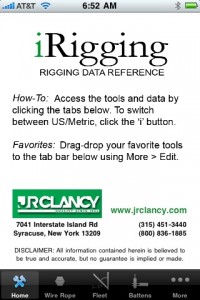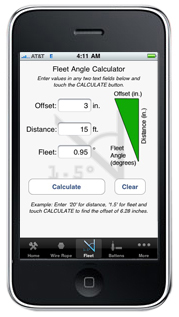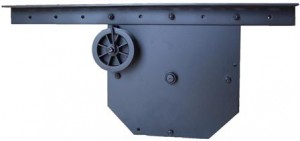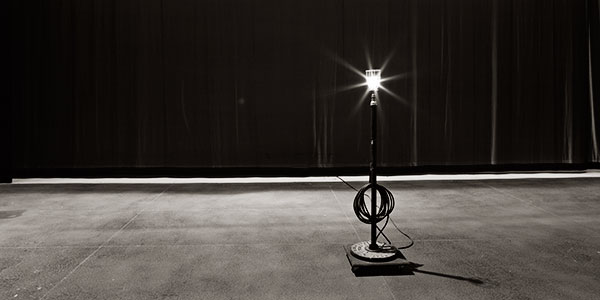JR Clancy’s Updates iRigging iPhone App
 Looks like JR Clancy just updated their iPhone app, iRigging. The first noticeable difference is the lacking of the Metric version of the App. When JR Clancy first released their iRigging app, they had two versions, one for Metric conversion and one for imperial conversion.
Looks like JR Clancy just updated their iPhone app, iRigging. The first noticeable difference is the lacking of the Metric version of the App. When JR Clancy first released their iRigging app, they had two versions, one for Metric conversion and one for imperial conversion.
Well, with the new update to iRigging, JR Clancy combined the two version into one. So rather then having to choose or switch between the two version of the app, you can now quickly and easily change from Metric to Imperial by clicking the information i on the top right of the app.
JR Clancy also added the ability to pull your favorite or most used portions of the app down to the black bar at the bottom of the app for quick reference. You can still access all of the other conversions and sections of the app under the more button on the right.
The iRigging App from JR Clancy is still a FREE download from the Apple iTunes App Store. To learn more about rigging and what JR Clancy can offer you, visit their web site at www.jrclancy.com. While on their site, besure to sign up for the Rigging Report email!
JR Clancy Rigging Report – Powered Fire Curtains

JR Clancy just released their latest Rigging Report and it has to do with some big changes made to Powered Fire Curtains standards. There are two new fire curtain standards in force, and both of them require powered operation for many more curtains than in the past.
NFPA 80 Standard for Fire Doors and Other Opening Protectives, 2007 Edition
- The standard requires that all framed fire curtains be power operated, as well as brail and straight lift curtains in proscenium openings greater than 850 sq. ft.
- The standard also specifies that “the fire safety curtain assembly shall be closed at all times except when there is an event, rehearsal, or similar activity.
American National Standard E1.22 – 2009 Entertainment Technology Fire Safety Curtain Systems
- This standard specifies that “non-emergency opening and closing shall be powered except straight lift unframed fire safety curtain systems for proscenium openings less than 925 sq. ft. shall be permitted to be unpowered.” Note that all framed and all brail curtains must be powered.
- It also specifies that “all fire safety curtains shall be in the closed position except during events with an audience, rehearsals, technical production activity, or activities on stage that necessitate the curtain be open.”
What Does It Mean?
- Fewer fire safety curtains are being mandated in theaters because of advancements in sprinkler systems.
- When fire safety curtains are required, there is an increased mandate that they actually perform correctly. This means an increased requirement for design, installation, testing, and routine inspection by “qualified” professionals.
- The requirement for closing curtains during unoccupied times provides additional protection to the theater and does so faster in case of a fire. It also provides another way of checking the operation of fire curtains routinely.
- Powered curtains are easy to raise and lower, making it more likely users will close the fire curtain when the theatre is not in use.
What About The Future?
- You’ll need to see if the local building code, project specifications, or architect require conformance to either of these standards.
- Expect building codes and insurance companies to require the requirement to keep safety curtains closed.
- A 925 square foot opening (850 sq. ft. under NFPA 80) is not very large (46 ft. x 21 ft. for example) so expect to see the majority of all fire curtains being powered in the future.
JR Clancy Introduces iRigging iPhone App
 I was blown away this afternoon when I received an email from JR Clancy announceing their latest product, iRigging. It is an iPhone app for figuring out rigging calculations and information. Here is more from the press release:
I was blown away this afternoon when I received an email from JR Clancy announceing their latest product, iRigging. It is an iPhone app for figuring out rigging calculations and information. Here is more from the press release:
It’s never been easier to get the equipment data you need for proper installation and operation of manual and motorized rigging. J. R. Clancy has turned its popular rigging slide rule tool into a free iPhone app, specifically for installers and users of theatre stage rigging.
The new app is called iRigging, and it delivers instant information about wire rope, batten loading, arbors, stage ropes, motors, fabrics, fleet angles, and more in English and metric units. It’s easy to install and use from an iPhone or iPod Touch.
iRigging provides wire rope data, including:
- Minimum sheave pitch diameter
- Quantity of cable clips
- Wire turnback for cable clips
- Proper torque for cable clip bolts
- Cable breaking strength
- Nicopress® sleeve crimp quantity and manual tool
Other data includes:
- Allowable fleet angles
- Uniform and midpoint batten loading
- Arbor capacity
- Weight of counterweights
- Recommended working loads for equipment
- Motor current
- Stage ropes
- Weight of stage fabrics
To learn more about the iRigging iPhone app from JR Clancy, visit their website at www.jrclancy.com. You can download the iRigging App for FREE from the iTunes app store. It is available separately for both imperial and metric.
JR Clancy Introduces Altus, A New Rigging Control
 I love the opening line to JR Clancy’s latest Press Release.. What kind of a system do you want controlling the heavy scenery over your students’ heads? Easy, something that won’t fall on them, or me! But seriously.
I love the opening line to JR Clancy’s latest Press Release.. What kind of a system do you want controlling the heavy scenery over your students’ heads? Easy, something that won’t fall on them, or me! But seriously.
JR Clancy is introducing a new, powerful rigging control called Altus at the LDI Show. More from the Press Release:
Created with middle and high schools in mind, Altus is based on a PLC computer platform—the same operating system that controls elevators, CNC manufacturing and assembly lines. Clancy put its long history with its popular SceneControl 500 rigging control system to work to create a system that’s as dependable and powerful as its leading controller—while making it affordable for schools.
Altus can control up to 36 hoists, each with individual ramp speeds for each cue. The console is available in wall mount, desktop or pedestal mount models, making the operation of rigging an ADA-compliant, accessible task for students with disabilities.
Students will love the easy-to-use, intuitive Altus touch screen, which allows them to create up to 200 cues with different speeds and trims for each hoist. Operators can name the cues, program each batten’s acceleration and deceleration, choose soft end-of-travel limits, and make adjustments on the fly with the built-in joystick.
“Altus is more suited to the backstage environment than controllers that run on an operating system meant for offices,” noted Tom Young, J. R. Clancy vice president of marketing. “Altus is sealed from outside elements like sawdust, dirt and other contaminants we find in the air backstage. While competitors’ units become clogged with dirt and eventually fail, Altus is unaffected—making it an excellent long-term investment for school use.”
For more information on the Altus, visit JR Clancy’s website at www.jrclancy.com or visit their booth at the LDI Show, # 1702.
JR Clancy Introduces New 56 Series Loft Blocks
 Just When you thought that there couldn’t be any new advanced in stage rigging, JR Clancy announces a new 56 Series of Loft Blocks. JR Clancy has rethought their most dependable, no-failure 55 Series of Loft Blocks and made some improvements to bring the 56 Series to life.
Just When you thought that there couldn’t be any new advanced in stage rigging, JR Clancy announces a new 56 Series of Loft Blocks. JR Clancy has rethought their most dependable, no-failure 55 Series of Loft Blocks and made some improvements to bring the 56 Series to life.
The 56 Series offers some new features:
- Quieter operation. The 56 Series features a new Quiet Idler, a remarkable noise-reducing idler that stays quiet, even at the higher speeds of many motorized sets.
- Greater capacity. We’ve increased the capacity to 750 pounds, up from the 500-pound capacity of our previous blocks.
We’ve kept all the excellent features you’ve come to expect from Clancy loft blocks:
- Ease of use. The new 56 Series Universal Loft Block is as easy to install as its predecessors. Base angles with continuous, alternating slots and holes permit installation in a wide variety of field conditions—so your installers don’t have to drill new holes in the field.
- Sturdy materials. The new blocks are available with either nylon or grey iron sheaves. With the nylon sheaves you get a 750 lb capacity, lighter weight, lower cost, and less wear on the lift lines. Blocks with iron sheaves have a 500 lb capacity, due to their lower read pressure rating.
- Flexible installation. The loft block can be installed in many different situations: upright, underhung, or with a pivot.
- Standard or custom. In addition to our standard blocks, J. R. Clancy can provide custom blocks for any environment.
Get more information about JR Clancy’s new 56 Series of Loft Blocks by visiting their website at www.jrclancy.com. If you are attending the LDI Show in Orlando this year, stop by the JR Clancy booth, 1702 to talk to a sales rep about the new 56 Series Loft Black.
JR Clancy Rigging Report: The Ghost Light

Copyright 2009 Paul Butzi - www.butzi.net
This weeks JR Clancy Rigging Report brings us yet another Superstition that we theatre people take to heart, the Ghost Light. While the Ghost Light has a practical use while the stage is dark, there is a deeper meaning behind it.
Most theatres have a ghost. This fact is known from high schools in Iowa to The Majestic Theatre in New York City. Fortunately for those uneasy about being greeted by a supernatural cohabitant, there is a method of keeping these ghosts at bay that has been around for many years: the Ghost Light. Typically the Ghost Light is turned on before the theatre is closed for the night and left on center stage. This illumination has the power to keep the ghosts in hiding and the theatre safe for the living who may dare to enter.
The Ghost Light has a practical use as well. Backstage can be a dangerous place in the dark. There can be scenery, platforms, chairs, and many other items left on stage to be tripped over. There is also the danger of someone falling off the stage and into the seating or the orchestra pit. The Ghost Light provides enough light for a person to find the lighting control switch and navigate safely around the stage.
As technology has advanced, and energy efficiency takes hold, some theatres have replaced the ghost light with computer-programmed lighting or occupancy sensors. While this new technology may save energy, the question remains, will the ghosts again have free reign on our performance spaces?
Want to sign up for the JR Clancy Rigging Report, visit the registration site here.
JR Clancy Rigging Report: Theatrical Superstitions & Missing Catalogs

This months JR Clancy Rigging Report mentions something that almost every person in theatre knows about, but talks very little about it, Theatrical Superstitions. Why do we do such things? Why does a pitcher on a winning streak on wash hit uniform? It’s all about doing what ever it takes to keep winning or to put on a great show.
We have all heard about the common theatrical superstitions, such as never saying the name Macbeth in a theatre and never wishing a performer “Good Luck.” Here’s the lore behind one superstition with a rigging background.
Whistle While You Work…
Not in this business! Several years ago I was working at a theatre company in New Haven, Connecticut. It was about an hour before the show on opening night, and I was whistling along with a song on the radio while testing the motorized turntable when I was approached by the lead actor of the show and told to stop immediately or he would not go on!
When theatrical rigging was in its infancy, sailors who were familiar with pin rails, knots, and pulleys, were hired to fly the scenery and drapery. These sailors took what they knew about raising and lowering sails and applied it to the theatre. One tradition of sailing that made its migration to the theatre was whistling. The sailors/riggers would whistle across the stage to cue the movement of scenery. The superstition of never whistling on stage supposedly started when an actor was casually whistling on stage. One of the sailors thought that it was his cue, and lowered a piece of scenery onto the musical actors head.
While cue lights and headsets have replaced whistling as a form of communication, the superstition has lived on. So remember, next time you are working on stage and just dying to whistle along with that new Britney tune, think twice and stay alert!
Did you know that JR Clancy has been in the business for over 125 year? While doing some cleaning around the office lately, they noticed they were missing some of their older catalogs…
Our filing system is pretty good, but over decades things can go missing. As we enter our 125th year of doing business, we are trying to fill in some gaps so we are looking for your help in retrieving copies of our missing catalogs.
Please look in your file of Clancy information for a spare copy of the following catalogs:
- Catalog # 3 – Date: 1887 – 1888
- Catalog # 4 – Date: 1887 – 1888
- Catalog #13 – Date: 1896 – 1898
- Catalog #27 – Date: 1916 – 1918
- Catalog #29 – Date: 1918 – 1921
If you have any of these catalogs, JR Clancy is willing to pay the first person to send it in $200. Contact Rob Kaiser.
JR Clancy Introduces New SureBrake II on PowerLifts
We recived a Press Release from JR Clancy that they have developed a new Braking System for the PoweLift hoist system, SureBrake II. The SureBrake II increases the safety and reliability by having a faster acting load brake to catch any failure before a batten becomes a runaway.
Read more from The Press Release:
PowerLifts have a dual braking system – the primary brake is on the motor, and stops the motor at the end of a move. The load brake is a redundant brake acting on the drum shaft for added safety. Since it’s on the output side of the gearbox, it’s a much heavier (and more expensive) brake than the primary brake.
“The current load brake is a Weston brake,” said J. R. Clancy engineer Pete Svitavsky. “It has some great features such as self adjustment and purely mechanical ‘self energizing’ actuation. However, due to the amount of energy it absorbs whenever the machine moves downward, there is a practical limit to the size and speed of the load it can control.”
The new electric brake is spring applied and electrically released, acting on the drum shaft. In contrast to the Weston brake, which is applied each time the load is lowered, the new brake is not applied during normal operation, reducing wear and noise.Speed sensors on the motor and drum shaft let the system compare the actual speed with both the commanded speed and maximum speed. The sensors can also monitor the integrity of the shafting and gearbox, for an added level of security. These sensors can detect problems at the moment they occur and respond quickly. This minimizes the stopping distance as well as the forces on the rigging and the payload.
PowerLifts with SureBrake II will begin shipping in the late summer. For more information on J.R. Clancy, visit www.jrclancy.com.
JR Clancy Announces New Batten End Caps

JR Clancy Recently announced the release of a new Batten End cap that allows flexiable numbering of battens. The new batten end cap allsows rigging ops the ability to quickly and easily number and identify battens from the deck or the grid.
More from the Press Release:
The bright yellow plastic end caps cover the ends of standard pipe battens. The new end caps feature a writeable surface on which rigging technicians can record the batten number using a permanent marker. If additional linesets are added during production, the operator can simply move the end caps, adding the new batten’s number on its end cap.
“The batten number has to correspond with the rope lock and line set at the rail, or with the line set number on automated controls – or technicians will find themselves moving the wrong line set,” said Tom Young, J. R. Clancy Vice-President of Marketing. “Now we’ve made it easy to coordinate the batten number and the controls, which will help theatre staff avoid incorrect cues – and even accidents – onstage.”
The end caps also include a space to record set capacity information, so users will know exactly how much weight each batten can hold – and when the batten is over capacity. “Far too many users have no idea what their set capacities are,” said Young. “By making these new end caps available, we hope to reduce the number of hazardous situations created by overloaded battens and out-of-balance loads.”
To learn more about the Batten End Cap, visit JR Clancy’s website at www.jrclancy.com.
LatestHeadlines
- Upgrading Your Toolbox: City Theatrical DMXcat-E and DMXcat Multi Function Test Tool
- Claypaky Bringing Back the Sexy to Par Cans with the Midi-B FX
- Ayrton Evolves the Cobra, the Cobra2 Developed for the US Market
- MA Lighting Intros grandMA3 onPC Fader Wing and DIN-Rail Nodes
- Live Events LEVL Up Fest: A Festival to Aid our Industry